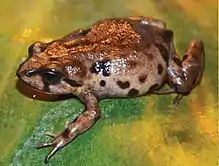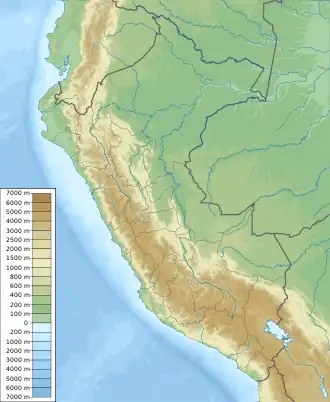| Phrynopus juninensis | |
|---|---|
 | |
| Scientific classification | |
| Domain: | Eukaryota |
| Kingdom: | Animalia |
| Phylum: | Chordata |
| Class: | Amphibia |
| Order: | Anura |
| Family: | Strabomantidae |
| Genus: | Phrynopus |
| Species: | P. juninensis |
| Binomial name | |
| Phrynopus juninensis (Shreve, 1938) | |
 | |
| Phrynopus juninensis is only known from Cascas in Department of Junín, Peru | |
| Synonyms[2] | |
| |
Phrynopus juninensis is a species of frog in the family Strabomantidae.[1][2] It is endemic to Peru and only known from Cascas near Huasihuasi, Department of Junín. Records from Department of Pasco probably belong to another species.[1] Common name Junin Andes frog has been proposed for this species.[1][2]
Description
A relatively large species of its genus, Phrynopus juninensis males measure 22–31 mm (0.9–1.2 in) and females 33–41 mm (1.3–1.6 in) in snout–vent length.[3][4] The snout is rounded in lateral view. No tympanum is present. The toes have no webbing. Dorsal coloration is dark brown with tan spots above and silvery-white flecks below. The lips are pale grayish tan with dark brown bars. The iris is bronze.[3] There are dark brown canthal and supratympanic stripes.[4]
Habitat and conservation
Phrynopus juninensis inhabits primary montane cloud forest and forest edges[1] at elevations of about 3,508–3,525 m (11,509–11,565 ft) above sea level.[1][4] It is a terrestrial species. Development is direct[1] (i.e, there is no free-living larval stage[5]).
Known only from a single location, P. juninensis is an uncommon and rarely seen species. It is threatened by habitat loss caused by agricultural activities. It is also potentially threatened by harvesting of Sphagnum mosses. It is not known to occur in any protected areas.[1]
References
- 1 2 3 4 5 6 7 8 IUCN SSC Amphibian Specialist Group (2018). "Phrynopus juninensis". IUCN Red List of Threatened Species. 2018: e.T57213A89211539. doi:10.2305/IUCN.UK.2018-1.RLTS.T57213A89211539.en. Retrieved 14 November 2021.
- 1 2 3 Frost, Darrel R. (2022). "Phrynopus juninensis (Shreve, 1938)". Amphibian Species of the World: An Online Reference. Version 6.1. American Museum of Natural History. Retrieved 16 October 2022.
- 1 2 Cannatella, David C. (1985). "The systematic status of Syrrhophus juninensis Shreve (Anura, Leptodactylidae)". Proceedings of the Biological Society of Washington. 98: 774–777.
- 1 2 3 Lehr, Edgar; von May, Rudolf; Moravec, Jiri & Cusi, Juan Carlos (2017). "A new species of Phrynopus (Amphibia, Anura, Craugastoridae) from upper montane forests and high Andean grasslands of the Pui Pui Protected Forest in central Peru". ZooKeys. 713: 131–157. doi:10.3897/zookeys.713.20776. PMC 5704321.
- ↑ Vitt, Laurie J. & Caldwell, Janalee P. (2014). Herpetology: An Introductory Biology of Amphibians and Reptiles (4th ed.). Academic Press. p. 166.
